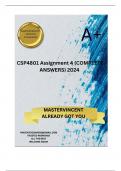,CSP4801 Assignment 4 (COMPLETE ANSWERS) 2024 -;
100% TRUSTED Complete, trusted solutions and explanations.
1. Emotional intelligence is described as a skill that helps people
understand and manage their emotions and behaviours. It is
therefore deemed important that teachers help their learners
understand and control their emotions because “learning is likely
to be more effective if educators help to minimise stress and fear
at school, teach students emotional regulation strategies, and
provide a positive learning environment that is motivating to
students” (Hinton, Miyamoto & Della-Chiesa, 2008). Lerato is a
newly qualified Mathematics and English First Additional
Language teacher at an under resourced primary school.
Interested to understand the concept of emotional intelligence,
Lerato decided to explore her Grade 6 learners’ emotions by
asking them to complete tasks in Mathematics and English First
Additional Language. She observed her learners while doing
their tasks and took some notes. The data she gathered showed
that some learners experienced positive emotions while others
experienced negative emotions during the task completion. The
negative emotions included frustration, boredom, annoyance,
anger, lack of interest in doing the task and some anxiety. The
positive emotions included pride and happiness. Using
motivation and behavioural theories (and any relevant model),
design intervention strategies or guidelines to help Lerato
address the negative emotions the learners experienced. (25)
Marking guide Level Understanding and Application of
Theories (25) 5 (Excellent) Comprehensive understanding and
exceptional application of EI, motivation, and behavioural
, theories, with insightful connections. Innovative, well-thought-
out, detailed, and highly relevant strategies that are feasible and
likely to be effective. 4 (Good) Good understanding and solid
application of EI, motivation, and behavioural theories, with
some insightful connections. Well-designed and detailed
strategies that are relevant, feasible, and likely to be effective. 3
(Satisfactory) Satisfactory understanding and adequate
application of EI, motivation, and behavioural theories, with
basic connections. Adequately designed strategies that are
relevant and feasible but may have minor effectiveness issues. 2
(Needs Improvement) Limited understanding and weak
application of EI, motivation, and behavioural theories, with
weak connections. Poorly designed strategies with significant
gaps in relevance, feasibility, or effectiveness. 1 (Poor) Minimal
understanding and poor application of EI, motivation, and
behavioural theories, with no clear connections. Strategies are
not relevant or feasible and unlikely to be effective.
To help Lerato address the negative emotions experienced by
her Grade 6 learners, we'll use emotional intelligence (EI),
motivation, and behavioral theories to design intervention
strategies. Here’s a detailed approach:
1. Emotional Intelligence (EI) Theory
Overview: EI involves the ability to recognize, understand,
manage, and utilize emotions effectively. For Lerato’s





